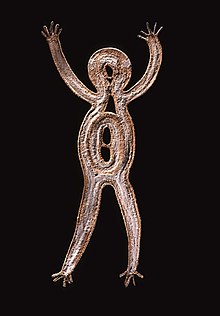
A mask is an object normally worn on the face, typically for protection, disguise, performance, or entertainment, and often employed for rituals and rites. Masks have been used since antiquity for both ceremonial and practical purposes, as well as in the performing arts and for entertainment. They are usually worn on the face, although they may also be positioned for effect elsewhere on the wearer's body.

African art describes the modern and historical paintings, sculptures, installations, and other visual culture from native or indigenous Africans and the African continent. The definition may also include the art of the African diasporas, such as: African-American, Caribbean or art in South American societies inspired by African traditions. Despite this diversity, there are unifying artistic themes present when considering the totality of the visual culture from the continent of Africa.
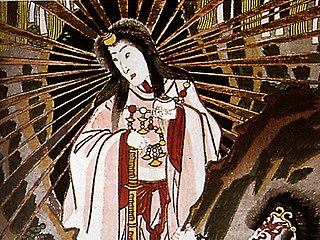
Yūrei are figures in Japanese folklore analogous to the Western concept of ghosts. The name consists of two kanji, 幽 (yū), meaning "faint" or "dim" and 霊 (rei), meaning "soul" or "spirit". Alternative names include Bōrei (亡霊), meaning ruined or departed spirit, Shiryō (死霊), meaning dead spirit, or the more encompassing Yōkai (妖怪) or Obake (お化け). Like their Chinese, Korean, and Western counterparts, they are thought to be spirits barred from a peaceful afterlife.
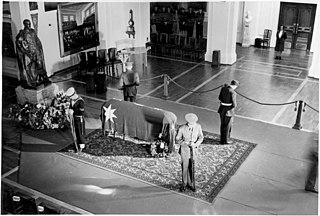
A state funeral is a public funeral ceremony, observing the strict rules of protocol, held to honour people of national significance. State funerals usually include much pomp and ceremony as well as religious overtones and distinctive elements of military tradition. Generally, state funerals are held in order to involve the general public in a national day of mourning after the family of the deceased gives consent. A state funeral will often generate mass publicity from both national and global media outlets.

Hieros gamos, hieros (ἱερός) meaning "holy" or "sacred" and gamos (γάμος) meaning "marriage," or Hierogamy, is a sacred marriage that plays out between gods, especially when enacted in a symbolic ritual where human participants represent the deities.
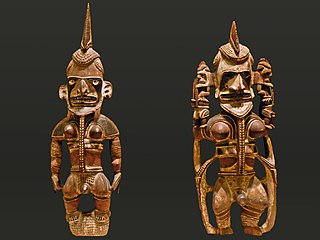
Uli figures are wooden statues from New Ireland in Papua New Guinea. Like their neighbors to the north and south, the artistic traditions of the peoples of central New Ireland formerly focused largely around mortuary rites. In contrast to the intricate malagan carvings of the north, artists in central New Ireland produced less ornate but more permanent figures known as uli, which were kept and reused many times. No longer made today, uli were displayed as part of lengthy fertility rites involving the exhumation and reburial of human skulls, which accompanied the planting of sacred plants.

A metate is a type or variety of quern, a ground stone tool used for processing grain and seeds. In traditional Mesoamerican cultures, metates are typically used by women who would grind nixtamalized maize and other organic materials during food preparation. Similar artifacts have been found in other regions, such as the sil-batta in Bihar and Jharkhand, India as well as other grinding stones in China.
The Navajo song ceremonial complex is a spiritual practice used by certain Navajo ceremonial people to restore and maintain balance and harmony in the lives of the people. One half of the ceremonial complex is the Blessing Way, while the other half is the Enemy Way.

The Aztec religion is a polytheistic and monistic pantheism in which the Nahua concept of teotl was construed as the supreme god Ometeotl, as well as a diverse pantheon of lesser gods and manifestations of nature. The popular religion tended to embrace the mythological and polytheistic aspects, and the Aztec Empire's state religion sponsored both the monism of the upper classes and the popular heterodoxies.

Vasudhārā whose name means "stream of gems" in Sanskrit is as known call as "Gold Tara", is the Buddhist goddess of wealth, prosperity, and abundance. Her popularity peaks in Nepal where she has a strong following among the Buddhist Newars of the Kathmandu Valley and is thus a central figure in Newar Buddhism. She is one of the most popular goddesses worshipped in many Buddhist countries and is a subject of Buddhist legends and art.

Kuksu was a religion in Northern California practiced by members within several Indigenous peoples of California before and during contact with the arriving European settlers. The religious belief system was held by several tribes in Central California and Northern California, from the Sacramento Valley west to the Pacific Ocean.

Bora is an initiation ceremony of the Aboriginal people of Eastern Australia. The word "bora" also refers to the site on which the initiation is performed. At such a site, boys, having reached puberty, achieve the status of men. The initiation ceremony differs from Aboriginal culture to culture, but often, at a physical level, involved scarification, circumcision, subincision and, in some regions, also the removal of a tooth. During the rites, the youths who were to be initiated were taught traditional sacred songs, the secrets of the tribe's religious visions, dances, and traditional lore. Many different clans would assemble to participate in an initiation ceremony. Women and children were not permitted to be present at the sacred bora ground where these rituals were undertaken.

Hopi katsina figures, also known as kachina dolls, are figures carved, typically from cottonwood root, by Hopi people to instruct young girls and new brides about katsinas or katsinam, the immortal beings that bring rain, control other aspects of the natural world and society, and act as messengers between humans and the spirit world.

In the neopagan religion of Wicca a range of magical tools are used in ritual practice. Each of these tools has different uses and associations and are commonly used at an altar, inside a magic circle.

Kwakwaka'wakw art describes the art of the Kwakwaka'wakw peoples of British Columbia. It encompasses a wide variety of woodcarving, sculpture, painting, weaving and dance. Kwakwaka'wakw arts are exemplified in totem poles, masks, wooden carvings, jewelry and woven blankets. Visual arts are defined by simplicity, realism, and artistic emphasis. Dances are observed in the many rituals and ceremonies in Kwakwaka'wakw culture. Much of what is known about Kwakwaka'wakw art comes from oral history, archeological finds in the 19th century, inherited objects, and devoted artists educated in Kwakwaka'wakw traditions.

Kulap figurines of limestone or chalk were made in Melanesia. The small funerary sculptures from New Ireland were associated with death rituals. They are typical in the hilly Punam region of the New Ireland province in Papua New Guinea of the Bismarck Archipelago. They were believed to contain the soul of the deceased person whom they were meant to represent, and would be ritually smashed once their usefulness or the period of mourning was over. In more recent years, some have been sold in their intact forms to Westerners, particularly to German administrators.
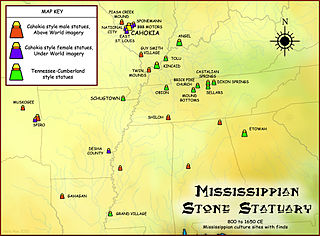
The Mississippian stone statuary are artifacts of polished stone in the shape of human figurines made by members of the Mississippian culture and found in archaeological sites in the American Midwest and Southeast. Two distinct styles exist; the first is a style of carved flint clay found over a wide geographical area but believed to be from the American Bottom area and manufactured at the Cahokia site specifically; the second is a variety of carved and polished locally available stone primarily found in the Tennessee-Cumberland region and northern Georgia. Early European explorers reported seeing stone and wooden statues in native temples, but the first documented modern discovery was made in 1790 in Kentucky, and given as a gift to Thomas Jefferson.
The Mbole people are an ethnic group of about 150,000 people living in the Orientale Province, southwest of Kisangani in the Democratic Republic of the Congo. The Mbole were previously referred to as Bambole.

This early twentieth century woman's ceremonial skirt from the Indonesian island of Sumba is part of the textiles collection of the Indianapolis Museum of Art, which is in Indianapolis, Indiana. Also known as a lau hada, the skirt would have been a nuptial gift for a woman of great social standing, since it is made of imported, machine-woven cotton cloth, glass trade beads, and nassa shells, which were once used as currency.

Fertility was often mentioned in many mythological tales. In mythology, fertility deities exist in different belief systems or religions.
